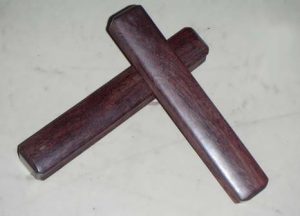Claves is an instrument that belongs to the percussion category. It is an instrument that is an integral part of Latin American music of all genres. The sounds of the percussion instrument resonates in all salsa music as well as in dance music like Mambo and Rumba. The instrument exists in different varieties which are used throughout in Cuba, Latin America as well as in US. You will also find the instrument’s sound incorporated in many modern music forms these days. this percussion instrument is also a teaching tool. Children can be easily taught the use of this instrument as there are no notes involved and kids become aware of rhythms as well as differentrhythmic patterns by learning to use the music instrument.
About the instrument
 When we talk of a set of claves it is usually a wooden instrument as per its original form. Nowadays even plastic or fiberglass variants are available. The instrument comprises of two sticks. One stick needs to be held in the palm of one hand while the other is held in the other hand. Sound is created when the stick on the palm is struck. This is the male clave while the striking stick is the female clave. The sticks might vary in size but in general the claves are usually eight inches in length and are about an inch in thickness. Claves are usually dowel shaped with rounded and ends that are evenly cut. Many say that the Cubans invented this percussion instrument though there are influences of aboriginal tribes of American, Spanish and African origins as well.
When we talk of a set of claves it is usually a wooden instrument as per its original form. Nowadays even plastic or fiberglass variants are available. The instrument comprises of two sticks. One stick needs to be held in the palm of one hand while the other is held in the other hand. Sound is created when the stick on the palm is struck. This is the male clave while the striking stick is the female clave. The sticks might vary in size but in general the claves are usually eight inches in length and are about an inch in thickness. Claves are usually dowel shaped with rounded and ends that are evenly cut. Many say that the Cubans invented this percussion instrument though there are influences of aboriginal tribes of American, Spanish and African origins as well.
Similarities with other instruments
There are similar instruments that resemble claves and are used in different parts of the world. For instance, Asian music genres have many percussion instruments similar to claves. This is one of the most basic percussion instrument that is used in Spanish music though there are other variants found as well.
Mastering the instrument
It should not be assumed that playing the instrument is simple, only about banging two sticks together to create a rhythm. Indeed, playing the clave takes mastery and skill. Players create certain rhythmic patterns with the instrument that need to be rhythmic and consistent. Those who master the instrument learn how to modulate the sound as well. this depends on how and where one strikes the male clave. The skill in playing the instrument depends on the force, area as well as speed at which the clave is struck. This is a skill that develops with practice and with the right teaching by master instrumentalists.
One can explore this instrument as it is an inexpensive one to procure. Children as well as learners of music can easily procure the instrument. There are different varieties of the instrument available though rosewood variety is considered the best. Depending on the material, the instrument’s sound also changes. For instance, the fiberglass material also produces a unique sound. Many claves are hollow for gaining certain resonance and tone.
Spanish music has over the years been a very important part of European music as it played a vital role in western music development. It was also a major influence on the music in Latin America.